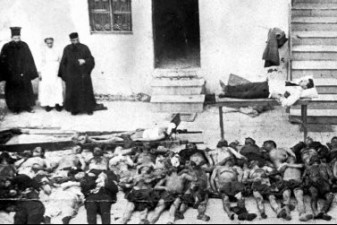
27/04/2015 16:53
Armenian Genocide was elaborated plan with racist motives
“Today, a hundred years later, the international community still has not officially recognized one of the gloomiest exterminations in the modern history which claimed 1.5 million lives,” the article published on the website of the Spanish online newspaper Público reads.
As the article has it, an eyewitness of the horrors, Diarbaker Pakradouni, could not help crying and connect words coherently to talk about what he had suffered. In 1920, he was only 8 years old. Together with his mother and sisters, he left Armenia to start a new life in Lebanon; his father had been assassinated at the beginning of the massacres.
“I can never forget nor respect those who do not recognize what happened. It feels as if they deny my existence, as well as that of my family’s. That is a matter of identity. I am the direct consequence of the Genocide,” Diarbaker’s grandson, Ashod Pakradouni, 25, says.
The author writes that Ashod takes part in protests for the recognition of the Genocide. His father is an MP from the Armenian Tashnag party in Lebanon. He has already faced trouble for his struggle. A few years ago, the political leaders met the President of Turkey, Recep Tayyip Erdogan, in Beirut. A banner reading “Welcome, Erdogan” was put up in the square of Martyrs. When Ashod and his father went to remove it, the police intervened and they ended up in clashing.
The author points that after a deep study of the Armenian Question, historians of different nationalities came to the same conclusion: the Genocide was not the consequence of the World War, as the Turkish Government claims, but an elaborated plan of extermination the Armenian people with racist motives.
Lilit Alvaryan, an Armenian student who has grown up in Spain, says her great-grandmother Mari was a Genocide witness. She was from Bitlis, a town to the East of the modern Turkey. She lost her entire family during the Genocide and took refuge in a ship floating to France, where the director of the orphanage she stayed in adopted her when she was 6.
The author of the article pays attention to the fact that the history now repeats itself. Akim, 17, of Armenian origin, was obliged to flee to Lebanon because of the war in Syria. His ancestors in their time survived the Genocide and emigrated to Aleppo, and now he himself had to feel the terror on his own skin. His family is not the only one to survive the exile for the second time. Now they reside in the block Bourj Hammoud in the center of Lebanon capital. The majority of the Armenian refugees live here with the Armenian culture being retained in all its corners. Flags of red, orange and blue are hanging on its walls. The Armenian language can be heard more often here than Arabic, the official language of Lebanon. Throughout the April Bourj Hammoud prepared for the Centennial of the Armenian Genocide.
Maria Dosseman, 27, is a Lebanon-born Armenian working as a graphic designer. She travelled to the capital of Armenia, Yerevan, to pay tribute to the memory of the Genocide victims. Dosseman says that despite the disputes she does not want to have neither Israel, nor Turkey as enemies. She finds it necessary to look forward.
''We cannot drop an anchor in the past; we must go on living, leaving the hatred behind. I want to turn that page,'' she said.








